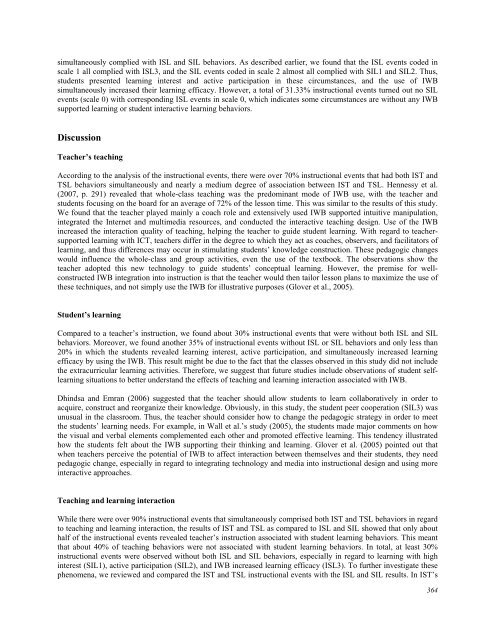October 2012 Volume 15 Number 4 - Educational Technology ...
October 2012 Volume 15 Number 4 - Educational Technology ...
October 2012 Volume 15 Number 4 - Educational Technology ...
You also want an ePaper? Increase the reach of your titles
YUMPU automatically turns print PDFs into web optimized ePapers that Google loves.
simultaneously complied with ISL and SIL behaviors. As described earlier, we found that the ISL events coded in<br />
scale 1 all complied with ISL3, and the SIL events coded in scale 2 almost all complied with SIL1 and SIL2. Thus,<br />
students presented learning interest and active participation in these circumstances, and the use of IWB<br />
simultaneously increased their learning efficacy. However, a total of 31.33% instructional events turned out no SIL<br />
events (scale 0) with corresponding ISL events in scale 0, which indicates some circumstances are without any IWB<br />
supported learning or student interactive learning behaviors.<br />
Discussion<br />
Teacher’s teaching<br />
According to the analysis of the instructional events, there were over 70% instructional events that had both IST and<br />
TSL behaviors simultaneously and nearly a medium degree of association between IST and TSL. Hennessy et al.<br />
(2007, p. 291) revealed that whole-class teaching was the predominant mode of IWB use, with the teacher and<br />
students focusing on the board for an average of 72% of the lesson time. This was similar to the results of this study.<br />
We found that the teacher played mainly a coach role and extensively used IWB supported intuitive manipulation,<br />
integrated the Internet and multimedia resources, and conducted the interactive teaching design. Use of the IWB<br />
increased the interaction quality of teaching, helping the teacher to guide student learning. With regard to teachersupported<br />
learning with ICT, teachers differ in the degree to which they act as coaches, observers, and facilitators of<br />
learning, and thus differences may occur in stimulating students’ knowledge construction. These pedagogic changes<br />
would influence the whole-class and group activities, even the use of the textbook. The observations show the<br />
teacher adopted this new technology to guide students’ conceptual learning. However, the premise for wellconstructed<br />
IWB integration into instruction is that the teacher would then tailor lesson plans to maximize the use of<br />
these techniques, and not simply use the IWB for illustrative purposes (Glover et al., 2005).<br />
Student’s learning<br />
Compared to a teacher’s instruction, we found about 30% instructional events that were without both ISL and SIL<br />
behaviors. Moreover, we found another 35% of instructional events without ISL or SIL behaviors and only less than<br />
20% in which the students revealed learning interest, active participation, and simultaneously increased learning<br />
efficacy by using the IWB. This result might be due to the fact that the classes observed in this study did not include<br />
the extracurricular learning activities. Therefore, we suggest that future studies include observations of student selflearning<br />
situations to better understand the effects of teaching and learning interaction associated with IWB.<br />
Dhindsa and Emran (2006) suggested that the teacher should allow students to learn collaboratively in order to<br />
acquire, construct and reorganize their knowledge. Obviously, in this study, the student peer cooperation (SIL3) was<br />
unusual in the classroom. Thus, the teacher should consider how to change the pedagogic strategy in order to meet<br />
the students’ learning needs. For example, in Wall et al.’s study (2005), the students made major comments on how<br />
the visual and verbal elements complemented each other and promoted effective learning. This tendency illustrated<br />
how the students felt about the IWB supporting their thinking and learning. Glover et al. (2005) pointed out that<br />
when teachers perceive the potential of IWB to affect interaction between themselves and their students, they need<br />
pedagogic change, especially in regard to integrating technology and media into instructional design and using more<br />
interactive approaches.<br />
Teaching and learning interaction<br />
While there were over 90% instructional events that simultaneously comprised both IST and TSL behaviors in regard<br />
to teaching and learning interaction, the results of IST and TSL as compared to ISL and SIL showed that only about<br />
half of the instructional events revealed teacher’s instruction associated with student learning behaviors. This meant<br />
that about 40% of teaching behaviors were not associated with student learning behaviors. In total, at least 30%<br />
instructional events were observed without both ISL and SIL behaviors, especially in regard to learning with high<br />
interest (SIL1), active participation (SIL2), and IWB increased learning efficacy (ISL3). To further investigate these<br />
phenomena, we reviewed and compared the IST and TSL instructional events with the ISL and SIL results. In IST’s<br />
364

















